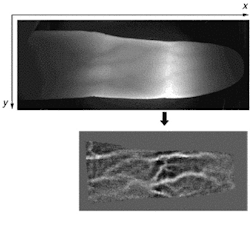
A group of researchers at Hitachi's Central Research Laboratory (Tokyo, Japan) have demonstrated a personal identification system using near-infrared (NIR) imaging of finger-vein patterns.1 The group claims its method is more accurate than voice verification and face recognition, and applies biometric technology without the contagion and unpleasant sensations caused by fingerprint recognition, iris scanning, and retinal scanning.
Shin-ichiro Umemura and colleagues at the Medical Systems Research Department developed an experimental prototype that transmits NIR light through a finger, images it with a charge-coupled-device (CCD) detector, enhances the pattern, and cross correlates images to positively identify subjects. A total of 678 subjects were accurately identified by unique vein patterns in their left little fingers with zero error.
The light source used was an array of Epitex NIR light-emitting diodes (LEDs) at a wavelength of 810 nm, the absorption wavelength corresponding to one of the fundamental vibration modes of water bonds. Flat plastic lenses were used to increase the number of diodes per length in the array. After the LED light passed through the dorsal side of the finger, the light level was manually adjusted and imaged by an infrared CCD camera with a neutral-density filter. Low-pass filters were used to subtract background intensity, and the similarity between the obtained image and the registered image was compared using a correlation coefficient.
The tilt angle of a finger from the horizon was calculated from the image of the finger edge and corrected to zero. The image size of the whole finger from the CCD was 640 × 480 pixels, which could be reduced by factors of two in the x and y directions without losing accurate identification results. Curve fitting for larger groups shows that NIR finger vein patterns may give a false acceptance rate of 0.043% for image sizes as small as 32 × 32 pixels, an accuracy equal to or better than iris and fingerprint identification.
The biggest problem with the finger-vein pattern-identification method is the possible change in vein patterns in the course of a human lifetime. Although the error rate in this study was negligible, the age of the chosen Japanese population averaged between 20 and 40, which preferentially tests a small variety of genetic and age variations. The researchers hope to follow up with further study on a larger group with greater genetic and age variation, and to track the finger vein pattern of children over long time periods.
Hitachi is pursuing commercialization of the technology, and is investigating applications of general use such as in automatic teller machines and patient identification in hospitals.
REFERENCE
- M. Kono et al., Appl. Opt. 41(35) 7429.
About the Author
Valerie Coffey-Rosich
Contributing Editor
Valerie Coffey-Rosich is a freelance science and technology writer and editor and a contributing editor for Laser Focus World; she previously served as an Associate Technical Editor (2000-2003) and a Senior Technical Editor (2007-2008) for Laser Focus World.
Valerie holds a BS in physics from the University of Nevada, Reno, and an MA in astronomy from Boston University. She specializes in editing and writing about optics, photonics, astronomy, and physics in academic, reference, and business-to-business publications. In addition to Laser Focus World, her work has appeared online and in print for clients such as the American Institute of Physics, American Heritage Dictionary, BioPhotonics, Encyclopedia Britannica, EuroPhotonics, the Optical Society of America, Photonics Focus, Photonics Spectra, Sky & Telescope, and many others. She is based in Palm Springs, California.
